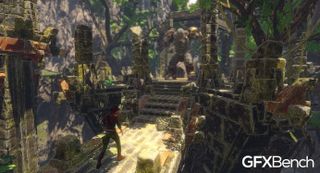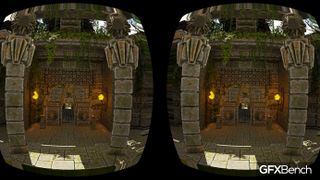Kishonti Adds Vulkan To GFXBench 5.0, Implements VR Benchmarks

Kishonti’s specialty is benchmarking, and the Hungary-based company has several apps, three of which cater to architects, professionals and the automotive industry. Another of its benchmark tools, GFXBench, tests the graphics capabilities of various APIs such as Open GL, Metal and DirectX 12. At the moment, the mobile-focused company is working on version 5.0 of GFXBench, which will support another API and includes a VR component.
Vulkan And A New Demo
Kishonti allows customers to try out the latest GFXBench version while it’s still in development, which opens the company to continuous feedback. One of the most popular requests has been to see GFXBench take on the Vulkan API. With GFXBench 5.0, the developers introduced a new demo called Aztec Ruins that harnesses the power of Vulkan,.
The short demo showed an Indiana Jones-like heroine as she approaches a monster made out of various pieces of stone. The main attraction to Aztec Ruins is the addition of Dynamic Global Illumination. This lighting method adds more detail to each in-game asset indirectly lit by sunlight, making the in-game surroundings a little more beautiful.
Other features of the demo include the ability to ease CPU load in mobile devices by scaling work processes to multiple threads, reducing the amount of commands for post-process effects on GPUs and boosting memory performance by having lighting and geometric passes utilize local memory caches. Sense a pattern? All of these improvements could increase a game’s overall visual quality while simultaneously reducing the stress on various components on your mobile device. With the new demo, Kishonti puts Vulkan alongside Metal and DirectX 12 as the main attraction for version 5.0.
Preparing For VR
High-end VR HMDs will soon be available for purchase, but it’s important not to forget about the mobile VR space. To that end, the company is also working on a VR benchmark application for mobile.
It will have two features. The benchmark mode, which uses the same location as the Aztec Ruins demo (and occurs off-screen), will calculate a score, keep track of frames per second, and measure latency and the game’s overall stability (the number of frames dropped). The second mode is more for entertainment; using the same Aztec Ruins location, you can show off the power of VR to your friends and family with a short demo.

The Build Continues
Stay on the Cutting Edge
Join the experts who read Tom's Hardware for the inside track on enthusiast PC tech news — and have for over 25 years. We'll send breaking news and in-depth reviews of CPUs, GPUs, AI, maker hardware and more straight to your inbox.
Just like previous versions of GFXBench, it seems that Kishonti will allow users to try out the early editions of version 5.0. The company wants to show a near-finished version for the public by the end of July, with a planned release sometime in Q3.
According to Kishonti’s partner manager Bence Varga, the goal of each version of GFXBench is to accommodate as many APIs as possible, while also providing users with an unbiased look at the graphics power of each. In fact, Gergely Juhasz said that the company won’t even release a benchmark unless three vendors publish it on three platforms. This allows users to download it from the company’s many partners and vendors (which include Nvidia, AMD, Dell, Samsung and Qualcomm).
With mobile gaming on the rise, companies like Kishonti are taking advantage of the opportunity to lay the foundations for future mobile API implementation as well as improvements to the mobile VR benchmark system. Developers could use the company’s tool to not only create better games, but to get an idea of how their title will work against GFXBench’s recent advancements.
Follow Rexly Peñaflorida II @Heirdeux. Follow us @tomshardware, on Facebook and on Google+.
Most Popular


